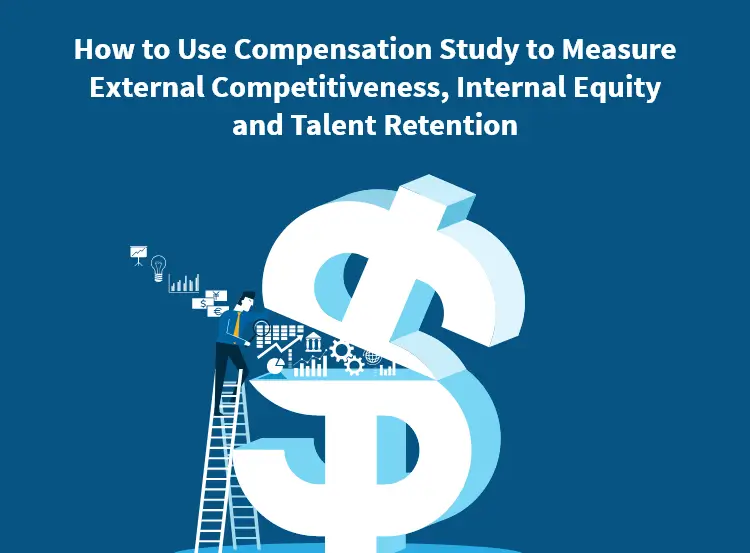How to Use Compensation Study to Measure External Competitiveness, Internal Equity and Talent Retention

- Step 1. Gather internal and external data.
- Step 2. Analyze competitiveness.
- Step 3. Assess internal equity.
- Step 4. Evaluate talent retention.
- Step 5. Identify issues.
- Step 6. Develop action plan.
- Step 7. Communicate and implement.
A comprehensive compensation strategy is incomplete without compensation study, as employers cannot make informed and competitive pay decisions without truly understanding the market. It helps organizations align their pay practices with industry standards, ensuring they remain attractive to top talent and retain staff.
In this article, you'll learn how to use a compensation analysis to measure external competitiveness, internal equity, and talent retention in your workforce. We'll also explore the definition, importance, factors, and challenges of running such a study.
What is compensation study?
A compensation study is an analysis that compares an organization's employee pay practices with those of similar organizations in the same industry and geographic location. It involves collecting and analyzing data on salaries, bonuses, benefits, and other compensation to see if the organization's pay is competitive.
A good compensation study helps organizations make smart decisions about employee pay by analyzing market trends. The compensation analysis also highlights any pay differences for similar roles within the company, allowing for fair adjustments.
Why is a compensation study important?
A compensation study is very important for companies for several reasons. Here are some key benefits:
Competitive advantage. A compensation analysis helps companies know market rates for jobs, so they can offer competitive salaries to attract and keep the best employees.
Informed decision making. Conducting a compensation study helps companies use data to make decisions about pay. This includes setting salaries, bonuses, and incentives, and managing resources efficiently.
Internal equity and fairness. A compensation study ensures employees are fairly paid based on their roles, responsibilities, and performance, which is essential for morale and reducing turnover.
Compliance with regulations. A compensation analysis ensures that companies meet legal requirements for compensation, such as minimum wage and equal pay regulations.
Signs your company needs a compensation study
Here are the common signs indicating that your company may need a compensation study:
Difficulty hiring qualified candidates
If your company has trouble hiring skilled candidates, it might be because your compensation isn't competitive. This could be because you offer lower salaries or fewer benefits than other companies. A compensation study can help you learn about market rates and change your compensation to attract better talent.
High employee turnover
High turnover rates could mean your compensation isn't keeping employees. They might be leaving for better-paying jobs. A compensation study can help you find where your pay and benefits are lacking so you can improve retention.
Employee complaints about unfair pay
Employee complaints about pay can show that your pay structure isn't fair. This can make morale low, reduce productivity, and increase turnover. Doing a compensation study can help you find and fix these issues so your employees feel valued and get paid fairly.
Lack of transparency in pay decisions
When pay decisions are unclear, employees might feel unappreciated or unsure about their pay. This can cause dissatisfaction and mistrust in the company. A compensation analysis can help you create clear and open pay policies, which can improve employee satisfaction and engagement.
Concerns about pay discrimination
If there are worries or complaints about unfair pay based on factors like gender or race, it's important to deal with these issues quickly and well. Doing a compensation analysis can help you find any pay differences based on these factors and make sure everyone is paid fairly.
Unfamiliarity with market rates
If your company is not regularly benchmarking its pay against market rates, you might not know if your pay is competitive. This can make it hard to hire and keep the best people. A compensation study can help you see what others are paying and adjust your compensation to stay competitive.
Reliance on outdated salary surveys
Using outdated and inaccurate salary surveys can result in misaligned compensation packages. This can make it hard to hire and keep good employees, and it can make pay inconsistent in your company. Conducting a compensation study with current and right compensation data can help you make better choices about your compensation strategy.
Inconsistent application of pay adjustments
If pay raises aren't fair or consistent between departments or roles, employees might feel unhappy and think it's unfair. This can lower morale and employee engagement. A compensation analysis can help you find and fix these issues so that pay raises are fair and the same across the company.
Challenges when running a compensation study
Conducting a successful compensation study can be complex, and several challenges can arise. Here are some common challenges when running a compensation analysis:
Data acquisition and accuracy. Getting accurate data on pay, job evaluations, and performance is challenging. It takes time and needs reliable sources like salary surveys or compensation databases.
Communication and transparency. When implementing a compensation analysis, ensuring accurate and fair job evaluations across the organization is critical. Evaluation methods must be reliable and consistent to avoid bias and ensure fair comparisons.
Cost and resources. Running a compensation study can be costly in terms of finances and staff time. Organizations must allocate enough resources for data gathering, analysis, job evaluations, and implementing changes.
How to use compensation study to measure external competitiveness, internal equity and talent retention
To measure external competitiveness, internal equity, and talent retention through a compensation analysis, follow these steps. Consider using tools like Salary.com's Compensation Software to simplify the process.
-
Step 1: Gather internal and external data
Collect detailed information about your organization's compensation practices, including base salaries, bonuses, incentives, benefits, and other forms of compensation. Also, gather external data from industry surveys and salary benchmarks to compare your practices with those of similar organizations. This ensures you have a complete picture of your organization's compensation landscape.
The Compensation Software has a Market Analysis feature that provides a comprehensive visual overview of both external and internal data. This helps ensure fair pay across your organization.
The software also provides accurate market pricing information by blending data from multiple sources. It delivers prices for every job in every pay market, even those not in traditional surveys, using reported pay data. You can access one of the largest job databases with over 15,000 unique job titles.
-
Step 2: Analyze competitiveness
After collecting the data, analyze it thoroughly to evaluate how competitive your organization's compensation packages are. Compare your compensation levels with external benchmarks to see if your pay rates are attractive enough to attract and retain top talent. Consider market trends, industry standards, and the cost of living in your region to ensure your compensation packages are competitive.
With Compensation Software, you can match your organization's job titles and descriptions with market data accurately. You can easily match your job to any compensation survey source or the tool's market data. The software also helps you find the right survey cuts for your composites through AI-recommended job matches and automated scopes.
-
Step 3: Assess internal equity
After analyzing external competitiveness, look internally to check if your compensation structure is fair. Evaluate if employees in similar roles, with similar experience and performance levels, are paid fairly and consistently. Identify any disparities or inconsistencies in your compensation structure.
The tool has a Pay Equity Analytics feature that identifies internal pay differences among employee groups and helps you correct them. You can easily compare pay and generate equal employment opportunity reports for protected classes such as age, ethnicity, and gender.
-
Step 4: Evaluate talent retention
Besides checking external competitiveness and internal fairness, it's important to assess how well your compensation practices retain top talent. Look at turnover rates, employee engagement levels, and other relevant metrics to see if your compensation strategy keeps key employees. Identify any patterns that suggest problems with your strategy.
-
Step 5: Identify issues
After analyzing external competitiveness, internal equity, and talent retention, pinpoint any problems or areas for improvement in your compensation strategy. These might include below-market pay, internal pay differences, or high turnover among key staff. By identifying these issues, you can create specific solutions to fix them and enhance your compensation strategy overall.
-
Step 6: Develop action plan
After identifying key issues from your compensation analysis, create a detailed plan to fix them. Outline specific steps, timelines, and the person who's responsible for making changes. Consider factors such as budget limits, legal rules, and what employees think when making your action plan. This ensures your plan is realistic and achievable.
With Compensation Software, you can easily adjust salary ranges, move jobs between ranges, and create new structures to align with your compensation strategy. The drag-and-drop editor makes this process simple. You can also forecast the costs of changing structures or adjusting individual employee pay.
-
Step 7: Communicate and implement
Lastly, communicate your action plan to employees and other important stakeholders and make the necessary changes to your compensation plan. Explain why you're making the changes and how they will benefit everyone. Good communication is important so that employees understand and agree with the changes, which can lead to successful implementation and better overall employee satisfaction and retention.
To keep your company ahead in the competitive job market, regularly evaluate and improve. Use a compensation study to gauge your competitiveness, fairness, and employee loyalty. By analyzing data and making data-driven decisions, you can build a compensation strategy that attracts talent, promotes fairness, and drives success. Salary.com's Compensation Software can assist you in this endeavor.
Insights You Need to Get It Right









